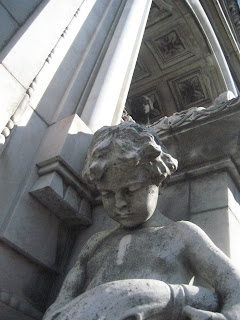The meeting started today, and after a relatively painless day ensconced in a purple-draped “teatro del cabaret” with 20 or so delegates from around the world, our group hopped onto a bus for our first dinner together, for what promised to be an exciting evening filled with Tango performers & glorious food. Unfortunately, we hit a few hiccups along the way…
After a solid hour of driving around Buenos Aires on a huge double decker bus (which I believe had “La Empresa del Turismo” inscribed on the back of every seat), our driver sheepishly admitted that he was lost and started asking random people on the street for directions… This marked the descent into absurdity of yet another chapter in what has already been a rather surreal travelogue comprised of misdirected trips. I personally find it damn amusing to be on a bus full of 30 foreign tourists in an unfamiliar city with no address and no sense of direction, but maybe that’s just my sense of humor. Displacement is always entertaining. Besides, that kind of collective disorientation amongst adults is a rare thing (at least, without substances ;-)), and although most of the people I was with were a bit perplexed and annoyed, we eventually stopped the bus, turned around, obtained some clearer directions, and managed to find our way to the destination in question. It was immediately christened “the bus ride to nowhere.” Being lost in a group of high maintenance executives is an adventure of sorts, shedding interesting light on characters and how they perceive and deal with time and delays. I’m lost in my own little world so often that it doesn’t really phase me to be floating around seemingly without bearings. To the rest of these hungry, self-directed individuals, it was more harrowing and got on their nerves. But we all get where we’re meant to go eventually, right? What’s the rush?
And the destination, on this particular evening, turned out to be a little slice of paradise…
Strolled through a huge, locked door in a completely unmarked building, then down a long hallway of what felt like someone’s lavish home, until I found myself walking past what looked like a very familial kitchen and dining area. The rest of the gang was gathered through a glass door, standing around on the back terrace, and I stepped outside again I found myself in a glorious yet discreet chic urban back yard. Someone was tending to some slow cooking chorizo on the grill, a fleet footed wait staff was circulating discreetly with plates, and suddenly everyone I’d just arrived with was holding a glass of good wine and settling in.
…Entre la
sommelier…
I had the pleasure and privilege of making the acquaintence of Fabricio Portelli, the editor of the best food&wine magazine in Argenina, El Conocedor...
Soon I was engaged in conversation with a tall, dark & handsome man with shoulder length locks & charm dripping off his jacket...talking about wine...in Spanish, no less... bad spanish, but Fabricio was patient company and more than willing to talk to me about Malbec & Torrontes, and our host,
the famed chef Dolli Irigoyen...
Turns out we were being fed by a celebrity chef, a woman famed throughout Argentina and beyond, cooking up a small feast of apertifs and cuisine at her own
private culinary house of experiments... talk about a treat...
as Fabricio and I talked, an attentive but unintrusive staff milled about with the following offerings: (my apologies for not remembering the appropriate names for it all...)
Empanadas
Chicken Skewers with Peanut Sauce
A warm creamy soup of pumpkin, or perhaps squash...
a divine fresh Ceviche
freshly grilled barbequed chorizo minisandwich... ("sliders! explaimed by new buddy from Detroit)
Egg Rolls
DeepFried goldenbrownballs speared with a stick
spoon-soft layered cornmeal cake/paella
Dinner was later, a divine steak accompanied with mashed potatoes and an array of fantastic wines.. ///Right at the moment i'm en route to dinner and must describe the rest of the evening, including the Tango performances at a later time... but let me say this... Fabricio told me that we were not in a restaurant, but una "Catedral de Vino" y "una labratoria gastronomica..." i've never feasted on such divinity as i dined on last night, and will describe the rest of it when i get a chance... more tango to come right now...

































 entric Bengali family, and the teas we'd all grown accustomed to over generations are the tame blends of black tea the British brought to India. It's definitely not the same plant they're making Yerba Mate from...i think...
entric Bengali family, and the teas we'd all grown accustomed to over generations are the tame blends of black tea the British brought to India. It's definitely not the same plant they're making Yerba Mate from...i think...















